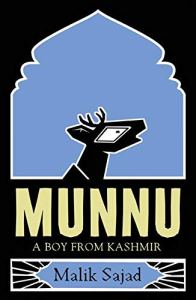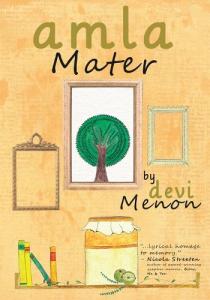
(available at Anchor.fm, Spotify, Apple Podcasts, Castbox, Google Podcasts, Stitcher, TuneIn, Breaker, Pocket Casts, RadioPublic, Overcast)
Hello and welcome to Episode 34 of Desi Books—news and views about desi literature from the world over. I’m your host, Jenny Bhatt. Thank you for tuning in.
Today, in the #FiveDesiFaves segment, we have Sabba Khan, who has a new debut graphic novel out in the UK titled The Roles We Play. She’s sharing her five favorite desi graphic works.
The transcript of this segment is also up on the website.
#FIVEDESIFAVES WITH SABBA KHAN — INTRODUCTION
Sabba Khan is a Newham, UK-based South Asian Muslim visual artist, graphic novelist, and architectural designer. Her work looks at unpacking rootlessness, displacement, and intergenerational trauma faced by migrant communities who sit in the aftermath of colonial legacy. She uses lived experience, memories, and oral histories to expose how wider policies affect our day to day. Her debut graphic memoir, The Roles We Play, has been published by Myriad Editions and supported by Jerwood Arts. She is a joint Eisner Award winner for Best Anthology 2020 for Drawing Power, where she was both the front cover artist and a key contributor.
Two-thirds of today’s British Pakistani diaspora trace their origins back to Mirpur in Azad Kashmir, a district that saw mass displacement and migration when it was submerged by the waters of a dam built after the Partition. Sabba Khan’s debut graphic memoir, The Roles We Play, explores what identity, belonging, and memory mean for her and her family against the backdrop of this history. She paints a vivid snapshot of contemporary British Asian life and investigates the complex shifts experienced by different generations within migrant communities, creating an uplifting and universal story that crosses borders and decades.
And now, here’s Sabba Khan.
[music]
#FIVEDESIFAVES WITH SABBA KHAN
Hi everyone. My name is Sabba Khan, author of the graphic novel, The Roles We Play Today.
I’ll be talking you through my top five graphic novels by other South Asian artists and writers. The list is:
- Amla Mater by Devi Menon
- Munnu by Malik Sajad
- Good Talk by Mira Jacob
- Bystander Anthology by Kadak Collective
- Mongrel by Sayra Begum
Sabba Khan’s debut graphic memoir is titled ‘The Roles We Play’. Catch up with her #FiveDesiFaves in graphic works by other desi writers-artists: Devi Menon; Malik Sajad; Mira Jacob; Sayra Begum; Kadak Collective. .@desibooks
Tweet
So to start off with, I’m going to dive into Amla Mater by Devi Menon. It was published by Yali Books in 2018 and, really, it’s a beautiful illustrated book. Illustrated and written by Devi. She’s a first-generation migrant and it looks at her story of living in East London, raising her family there, and just the memories she has of her home back in South India. So it really relates to me in a lot of respects. She talks about the ancestral village in South India, things that they used to do. It starts to center around this jar of amla—which is like a jar of pickle—and something that her family would do and she starts to do while she’s living in East London to remind herself of home.
There’s lots of parallels between her story and mine. She ends up with an English partner and someone who is not really as connected to her culture as she is. And so she finds herself in a situation where she really wants to formalize and galvanize what her culture, her home culture, means for her and how she brings that forward in her present life in East London. So there’s lots of beautiful drawings of her memories, lots of, kind of, philosophical and thoughtful drawings as well. Very simple as well, It’s black and white. It’s very beautiful.
So that’s Amla Mater.
“[Devi Menon] really wants to formalize and galvanize what her culture, her home culture, means for her and how she brings that forward in her present life in East London.” Sabba Khan on Amla Mater for #FiveDesiFaves .@DesiBooks
Tweet
Number two is Munnu: A Boy from Kashmir by Malik Sajad. Published by Fourth Estate in 2015. Munnu is a very big graphic novel in comparison to the Amla Mater. It’s also black and white and it’s very much about a little boy, a seven-year-old boy called Munnu and his experiences growing up in Kashmir in the 1990s. And it looks at his family, it looks at his friends, his childhood school, things around occupation, and the conflict between Kashmiri Hindus and Kashmiri Muslims.
And really it’s an intense, detailed, emotive story. You open it and the drawings are laden with detail and action and emotion. It’s incredibly, incredibly beautiful. I’ve been reading it very slowly and taking my time with it.

And those of you who know graphic novels will recognize—or at least for me, I look at it and—all of the characters have been drawn like, I guess, deer or antelopes. And that’s a familiar device that’s used in other graphic novels. I’m thinking of Maus now where they were looking at Germany in the 1940s. And the characters there were replaced with mice instead of human figures.
This one is incredible, it’s very political and obviously it’s rooted in Kashmir, which makes it a really fascinating window into life in that part of the world that, you know, a lot of us don’t really get to hear about in other ways other than through media, through newspapers and headlines, and just general news. So this one is a great one to really get an insight into people’s lives that live in Kashmir.
So that’s Munnu.
“[Munnu: A Boy from Kashmir is a] fascinating window into life in that part of the world that a lot of us don’t get to hear about other than […] through newspapers and headlines.” Sabba Khan on #FiveDesiFaves .@DesiBooks
Tweet

The third one is Good Talk: A Memoir in Conversations by Mira Jacob, published by Bloomsbury in 2019. This one—Mira Jacob is from the States, she’s American, and she’s South Indian—and this graphic novel, it’s full color. It’s slightly different to other graphic novels in that she uses characters and speech bubbles in a very simple way. Mira is also a journalist as well. So you can tell that her writing really comes at the fore in this and the illustrations are a vehicle for her writing, which is slightly different to other graphic novels. I think a lot of people—and me as well, I think, I came to graphic novels from the drawing discipline, from the arts discipline. So it’s really lovely to see a graphic novel where a person’s really strong in their writing and actually the characters and the visuals are really a vehicle to unpack that.
It’s called Good Talk because it’s conversations between her and her young child who is born out of her heritage and her partner’s heritage, who is American Jewish. So she ends up using that as a way to unpack intercultural relationships, the politics of the States at the time—Trump was in power.
And she’s actually really interesting to follow on Instagram and Twitter as well because she’s very current and explores lots of things on a regular basis on her platforms.
It’s an excellent book and it’s been nominated for lots of awards. It probably has won some awards as well just because it’s just so on point. And there’s moments in her book where I really related massively to them in terms of my own experiences. Stuff that I end up going into my book as well. Towards the end of my book, I end up talking about interracial relationships with my partner and just ideas around belonging and feeling when you end up—I think, for me, being in a intercultural relationship really brought to the forefront just how different our lives were despite the fact that we lived in the same country. Just the fact that we came from different cultural backgrounds, and different class backgrounds as well, had meant we had a completely different exposure to life and society as we knew it. And I think being in an intimate relationship really makes you see the other’s point of view. And also just really galvanizes your own. I think, for me, it was the first time I could compare with something and, you know, my partner’s white middle-class and that really just solidified a lot of the thoughts and feelings that I had already had as niggly doubts.
So that’s number three: Good Talk by Mira Jacob.
“. . . lovely to see a graphic novel where a person’s really strong in their writing and the characters and the visuals are really a vehicle to unpack that.” Sabba Khan on Good Talk for #FiveDesiFaves .@DesiBooks
Tweet
Number four is the Bystander Anthology. So bystander stories, observations, and witnessings from South Asia. A comics anthology presented by Kadak Collective. This one is really incredible because the collective published it themselves. It was supported by a Kickstarter. So everyone who pledged, gave pledges to them, in the year of 2019 got copies of the book and that was how it was funded and distributed and came into being. So it’s a real community collective effort.

And, really, what’s fascinating about the way they approached it is that they wanted to get an idea of the concept of the bystander: someone who sees and observes but doesn’t take action. They wanted to see what that means for South Asians across the world. So this is an anthology and they’ve invited over 50 contributors from over 13 countries across the world in a total of 44 pieces that really look at what that means on a global scale for the South Asian community, South Asian women, non-binary queer folk, people who use visual storytelling as a way to get across their experiences and, you know, their stories. So it’s a real feat and it’s a real, you know, kind of across time, landscape, and culture conversation. And the front cover is beautiful. It’s got the three monkeys of see no evil, hear no evil, do no evil, which is one of the sort of themes around the bystander concept. And, inside, when you open it, it’s full color, full print, absolutely gorgeous drawings from so many different artists.
It also includes my contribution as well. I have a small contribution. My piece looks at my architectural education and how I internalized a lot of othering and internalized a lot of racism within myself and started really feeling like a monstrous version of myself, too ugly to produce architecture or do anything that was suitable for contemporary architectural western standards. And how I became a bystander to my own humanity and to my own sense of self. So very heavy, loaded stuff. And the whole book is really like that. But it ranges from small, fleeting moments to big philosophical questions.
I think they’re working on making it accessible to people beyond the Kickstarter campaign. But it was published in 2020 and I know that it was only really people that pledged to the campaign that got copies of the book. But they’ve had such a huge positive, overwhelmingly positive, response that I think they’re working on getting copies beyond that time now. So, if you’re interested, then we can share where to sign up for more news on that one.
“[With the Bystander Anthology, the Kadak Collective] wanted to get an idea […] of someone who sees and observes but doesn’t take action […] what that means for South Asians across the world.” Sabba Khan on #FiveDesiFaves .@DesiBooks
Tweet

Last, but not least, is Mongrel by Sayra Begum published by Knockabout in 2020. Mongrel is Sayra’s autobiographical novel. I actually met Sayra the year before at the Lakes Comics Festival. I think it was actually in 2018 when we met and that was the year that I received my publishing deal. Both Sayra and I—well, I don’t think we actually spoke, we ended up talking on social media after the event—but I saw one of her talks.
Her drawings are incredibly beautiful. She comes from an artistic background as well and her book explores similar themes to mine actually around family, around faith, around belonging. She herself is also in an interracial relationship, There’s a theme happening here. And she looks at her upbringing and how that’s shaped her decision-making and who she is and why she is what she is now. So, very similar themes. Absolutely stunning, beautiful body of work that I encourage everyone to buy and read and share. It’s called Mongrel and yes, it’s a lovely phenomenal piece of work.
It was really lovely meeting her and really recognizing that, actually, there’s so many ways to tell our stories. And you know, the graphic novel medium is one way of telling your story. But even within that, there’s actually so many ways. And what’s really fascinating is to see how the both of us have approached our work in similar yet different ways. And I think that just goes to show, with all of these pieces of work, we’ve all looked at heavy themes that—big topics, big conceptual, philosophical topics—that form us and shape us and yet are done in digestible, easily digestible, beautiful ways that are tender on the eyes.
“[Sayra Begum] comes from an artistic background as well and her book explores similar themes to mine actually around family, around faith, around belonging.” Sabba Khan on #FiveDesiFaves .@DesiBooks
Tweet
So that’s my top five recommended South Asian graphic novels for you. Take a look at each and every one of them. Buy all of them. Read all of them. And tell me what you think and I hope you like them.
And also buy my book as well. It’s a graphic novel. It’s called The Roles We Play. It came out literally last month in July 2021. It’s published by Myriad Editions. You can get it from all good bookstores, you can get it from online; just Google “The Roles We Play Sabba Khan” and it should come up.
Graphic novels, visual storytelling is the way forward. It’s a beautiful medium and I hope you like it and I hope you agree. Thank you very much. Bye.
[music]
You’ve been listening to episode 34 of Desi Books—news and views about desi literature from the world over. I’m your host, Jenny Bhatt. Today’s #FiveDesiFaves was from Sabba Khan sharing her favorite graphic works by desi writers. Her own graphic memoir, The Roles We Play, is out in the UK now.
Episode 35 will be up shortly. Follow on Twitter @desibooks, Instagram @desi.books, Facebook @desibooksfb. Tag the accounts if you have requests or suggestions. Email at desibooks@desibooks.co. And please go to the website if you’d like to sign up for the free, weekly newsletter.
Stay healthy, keep reading, and write well.
[music]
NOTE: If you like the work being done at Desi Books, you can leave some appreciative feedback and sign up for the free, weekly newsletter. And please share this with other readers who might be interested. Remember: A Rising Tide Lifts All Boats.™
Join the Conversation

